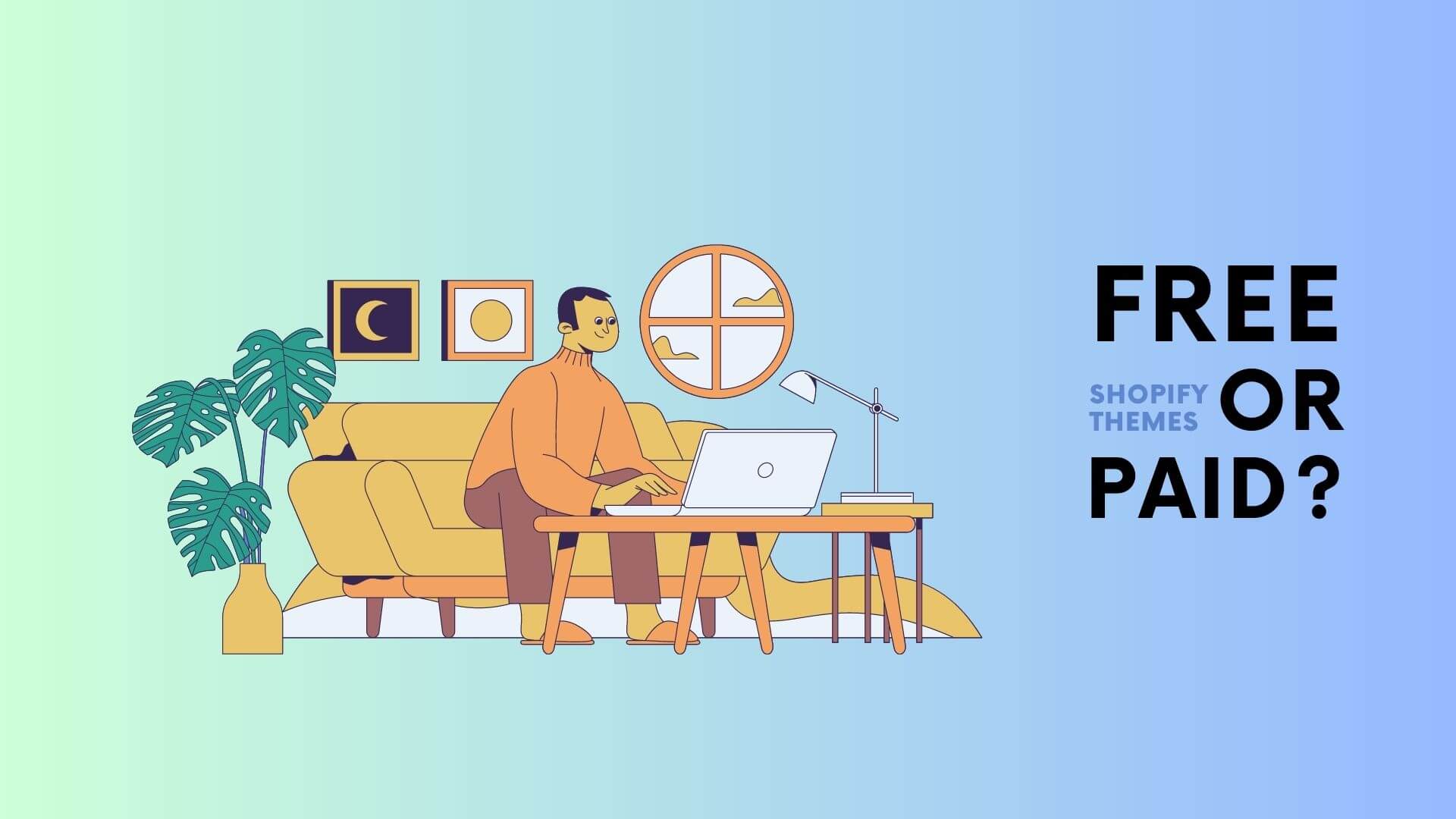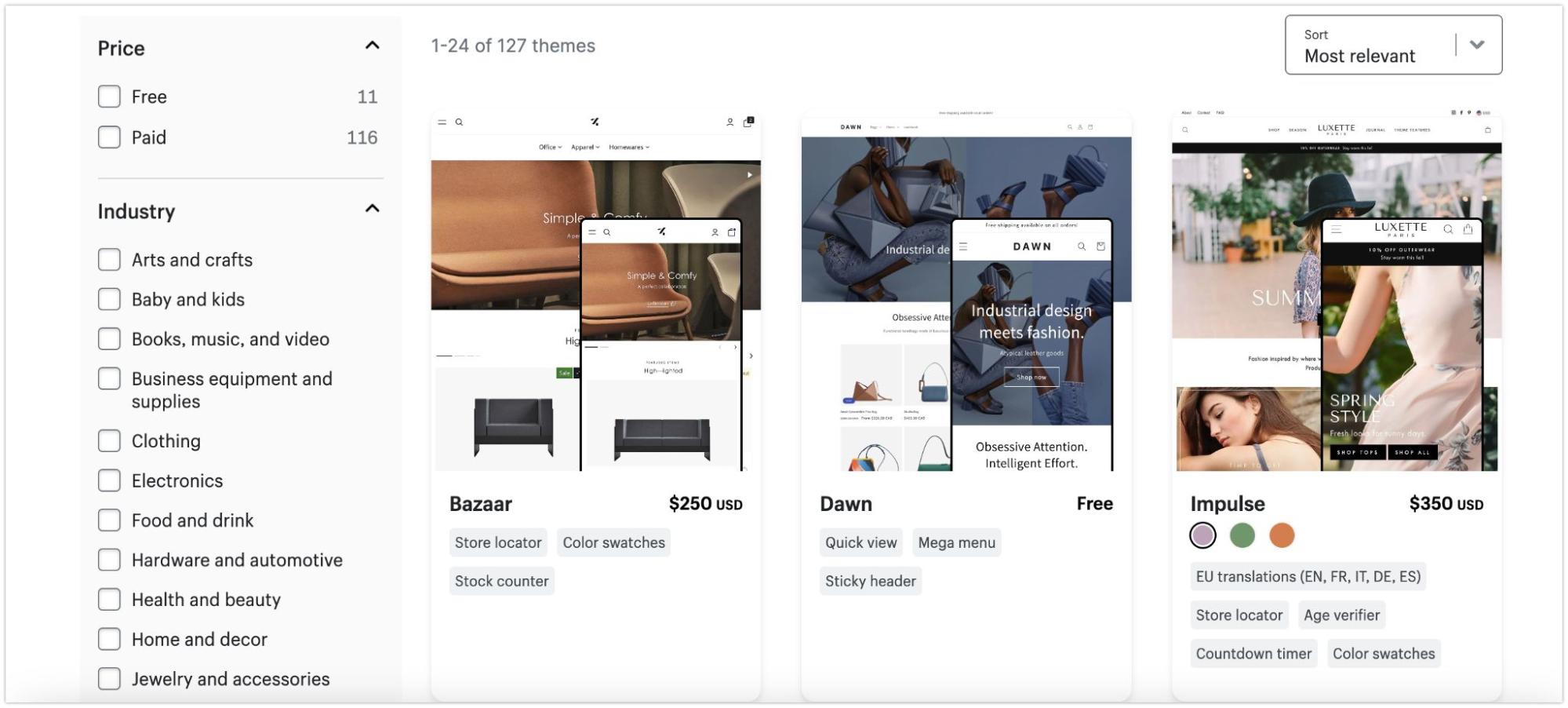
Choose between installing a free theme or buying a paid theme when you set up or upgrade your Shopify store. Although it seems like a straightforward choice, it can be challenging for some store owners, particularly those who are on a tight budget. Do you require a premium theme? Can you get by with a free one instead?
To assist you in making a choice, we will examine the distinctions between free and paid themes in this article.
What is a Shopify theme?
A Shopify theme is a pre-made template that manages your online store’s look and organisation. A theme is your website’s overall design, including its colours, fonts, structure, and features. It can be customised to match your brand and target market and serves as the basis for how your online store will look and feel.

Factors to consider when choosing a Shopify theme for your online store
Setting up an eCommerce store requires selecting the best Shopify theme. A theme affects your online store’s performance, design, features, customization, and usability, as well as how it feels, looks, and works. Choosing a theme for your store can be difficult because there are so many options available, but there are some important things to take into account.
- Performance: Both user experience and search engine optimisation depend on how quickly a website loads. Low user engagement and lower search engine rankings may be the results of a slow website.
- Design: In eCommerce, having a website with a good design is essential. A website that is both aesthetically pleasing and easy to use will draw and keep visitors, foster trust, and ultimately increase sales. Choose a theme that makes your online store stand out, is responsive for mobile devices, and complies with accessibility guidelines.
- Features: The amount of control you have over how customers interact with your store will depend on the features your theme offers. It’s crucial to choose a theme with the features your store needs. For instance, a large product catalogue will call for robust search and filtering capabilities as well as a mega menu.
- Customization: To make a theme your own, look for one that offers a variety of customization options. The theme should be flexible enough to meet your shop’s requirements effectively.
- Support: For your store to remain successful and experience fewer interruptions, you need a solid support system. A must-have is access to excellent documentation and direct support from the theme provider.
- Reviews: When looking for a new theme, reviews can be a great source of knowledge. Pay attention to the support’s effectiveness and responsiveness, the theme’s functionality, and how frequently it is updated. You can get a sense of what it is like to use a particular theme in a practical setting by reading reviews from real Shopify store owners.
- Price: A theme’s price can change. A free theme might be the best option, but you also have the option to pay for one, depending on your needs and financial situation. Be aware that installing additional apps or hiring a designer or developer to add more customization may result in additional costs.
- Where to purchase the theme: It’s crucial to think carefully about where you buy your theme. The Shopify Theme Store is a dependable source for high-quality themes because the themes have been reviewed and passed strict criteria for functionality and features. Additionally, when using themes from the Shopify Theme Store, you won’t have to worry about licencing issues. On the other hand, other marketplaces, like ThemeForest, have a large number of fake and subpar themes, so it’s important to use caution when making purchases there.
Shopify free themes vs. Shopify paid themes

There are two categories of Shopify themes: free and paid. The main distinction between a free and a paid Shopify theme is the features and options for customising the design. Both are excellent choices. Paid themes typically offer more options for customization of the design, functionality, and features that help you build a distinctive store. Free themes, on the other hand, frequently have fewer features and design options as well as a lower degree of customizability.
Contrasting premium and free themes for Shopify You must choose between a free and a paid Shopify theme when opening an online store. Although a free theme may initially be sufficient, we’ve discovered that many store owners feel their website is lacking without a paid version. To assist you in making an informed choice, here is a comparison of the advantages and disadvantages of free versus paid themes.
| FREE THEME | PAID THEME |
Price | No upfront cost
The only upfront expense for free themes is your monthly Shopify subscription. Despite the fact that free themes are a great place to start, you might also need to buy additional apps or work with a designer or developer to customise them. In the long run, investing in a paid theme can save you time and money because it can give you the extra features you require without requiring additional add-ons. | Upfront cost
The themes available on the Shopify Theme Store cost between $180 and $360. (one-time payment). Note that themes bought from other marketplaces do not adhere to the same strict requirements for quality and review as Shopify-approved themes do. |
Design | Simple design and layout
Limited options for customization. Free themes can be modified to some extent, but there aren’t many options, so your brand won’t stand out as much. | Extensive customization options
You can design the ideal look and feel for your store using more precise customization options that are easily brandable. Examples include including animations, enabling hover-over product details, and changing the distance between characters. |
Features | Standard features
The essential features included in free themes can quickly limit retailers’ options. Even though adding apps can help you further customise your theme, doing so frequently causes pages to load more slowly. Free themes typically take a while to get useful feature updates. | Advanced built-in features
Paid themes are frequently more effective, giving users more control over their browsing experience and doing away with the need for third-party apps. These themes might include mega-menus, countdown banners, advanced filtering options, etc. To keep your theme up to date with the newest eCommerce best practices, top theme developers frequently release updates and new versions (at no extra cost). |
Performance | Great performance
Although the site was designed with quick page loads, a simple user interface, and mobile usability in mind, the addition of third-party apps for more customization could compromise the site’s speed. | Great performance
Similar to the free themes, but more suitable for heavier loads. As page loading times can vary from theme to theme, we advise testing the speed of each theme. |
Support | Basic technical support
Provides direct theme assistance as well as documentation. | Advanced technical support
increased customer service (included in the price of the theme). Before making a purchase, read the theme reviews because the level of customer support offered by the theme developer agency can differ. |
Only paid themes available from Shopify’s Theme Store are examined in this comparison table. The quality of themes obtained from outside sources may not be as reliable because they are not subject to Shopify’s review process. These outside sources might provide more affordable choices, but it’s important to keep in mind that the saying “you get what you pay for” still holds true.
Who Should Use a Free Shopify Theme?
You have a limited budget
Look, nothing is wrong if you don’t have a lot of money lying around. So, if you want to spend as little money as possible on the promotion of your product, you should download a free Shopify theme. Just be sure to select the option that is consistent with your brand.
You’re in the Test Phase
If, for some reason, you’re still unsure about diving right into the Shopify business, don’t be confused with product testing. Perhaps you’re a little hesitant and want to see some progress before making a significant investment. A free theme would be preferable for your store in this situation.
You're Unsure of Your Own Brand
When they first start out, many dropshippers are unsure of their decision and have concerns about:
- Their product
- If their product will sell
- If they even continue in that niche or inventory size
You will use a free theme on your Shopify store if you share one of these problems. On second thought, I would still advise purchasing a premium theme that could cover several markets or even a general store. So, your predicament doesn’t result in you losing sales in an effort to save money by forgoing purchasing a premium Shopify theme.
Who Should Use a Paid Shopify Theme?
You’ve Got an Extra Budget
Without a doubt, using a premium theme in your shop will improve things. You ought to do this if you can afford to. There is nothing else to say about it. However, since there is a wide price range for the premium Shopify themes, it’s easy to find and stick with a theme that fits within your spending limit while still appearing to be a wise investment. After all, purchasing a theme merely for its own sake would be a waste of money.
There is no free theme for your niche
If you are creative, it might not be a problem. But if not, you’d be better off using a theme whose demo template was created especially for your market, so you can get started right away with a few minor adjustments. However, make sure that theme also includes a few essential conversion-enhancing elements. The goal is to have as few apps installed on your online store as possible.
You’ve Got a Specific Design in Mind
You’ve looked at your rivals’ websites and noticed a number of prosperous e-commerce businesses in different markets. Now, you already have a general idea of the layout or features your Shopify store should have. Then you should locate and purchase a premium theme that meets your unique requirements. However, you must never overspend in order to pay for it. If you don’t have much knowledge or experience with e-commerce, spending more than your store would bring in would be a mistake.
Our Recommendation?
Both free and premium Shopify themes have advantages and disadvantages.
Here is a brief summary of our conversation thus far: Choose a free theme if your product is straightforward and your audience is familiar with you. A free theme can be a good option if you don’t want to strain your budget. But if you want to set up a branded and expensive Shopify store, you’ll need a paid theme.
Conclusion
A free theme will do the trick for Shopify newcomers who are developing their brand identity or have a limited selection of products. Free themes should be regarded as a great place to start. When it’s time to switch to a paid theme, think about what features are effective for your store and keep those in mind for future use. A paid theme will help increase product visibility, strengthen your brand identity, and increase revenue for companies looking to expand in the upcoming years and expand their market reach. Although purchasing a paid theme may seem like a significant investment, it will ultimately be worthwhile.



